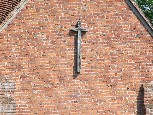| |
|
Braiseworth is a
forgotten little hamlet, bypassed by roads and
centuries. If Eye had grown to the size of,
say, Lowestoft, Braiseworth would be a
name in the suburbs, nothing more. Instead, you
meander along narrow lanes, mud-bespattered when
I came this way in the early spring of 2003,
mud-bespattered still in the summer of 2010.
There’s a couple of houses, not much more.
At a junction, there’s the surprise of a
little Victorian church, and you might think
you’ve found what you are looking for. But
you haven’t. The new Braiseworth St Mary was built by the maverick
genius EB Lamb in the 1850s, as a replacement for
the old church. Now, it is a private house, sold
off in the 1970s by the Diocesan
property-developers. It looks very domesticated
in its hedge-surrounded garden. But
you must press on, heading south, until an
unsigned lane leads off to your left. It feels
like a public road, but very quickly dwindles
into an unmade, rutted track, and loses itself in
a farmyard. A public footpath crosses here
between the farm buildings, but otherwise there
is no doubt that you are now on private property.
So, as you prepare your words of apology and turn
your car around, take a glimpse beyond the barn,
beyond the farmhouse, beyond the pond. You will
see something quite extraordinary, quite
unexpected; a graveyard. Here for centuries, on
this gentle hill, the people of Braiseworth came
to be buried. And this was their church - or,
part of it. All that survives is the chancel,
bricked off clumsily, with a rough wooden door.
The site itself is fenced off, and a sign warns Danger!
Aggressive Ram in Churchyard. It is a
silent, overgrown place, all the more haunting
for being almost completely unknown, completely
forgotten.
Or,
not quite. For those lost generations produced
children, and some of these spread out across the
world. And today, I receive e-mails from America,
Australia and New Zealand, from people
researching their roots. When they cannot find
information about Braiseworth church, they
wonder. Does it still exist? Is it still possible
to visit it? The graveyard is still full of
headstones, peering and tilting from the long
grass, but there isn’t much left of the
church.
On
Sunday, 30 March 1851, William Chenery, the
curate of Stuston, was fulfilling his duty
at this little outpost. On this particular
Sunday, in common with ministers of all
denominations across the land, he was required by
law to return a census form detailing attendance
at his church. This was the only time it ever
happened, and this unique occasion provides us
with a snapshot into the religious practices of
150 years ago. Of course, most ministers talked
up their congregations on the day, but even the
Reverend Chenery could only count 37 of them,
making this one of the smallest congregations in
Suffolk. And he had the grace to admit that it
was usually no more than 20.
When
the Victorians set about restoring the Church of
England to something like its former glory, they
rebuilt many of the decaying parish churches. In
Suffolk, this was almost always on the site of
the former church, but a couple of places it
wasn’t; Melton, for example, and Westley. And here; by the 1850s,
this church was a bit of a state, quite frankly,
so the new building was constructed up on the
main road. Bits were removed from the old church,
and incorporated into the new, including the two
Norman doorways to the former nave. Perhaps the
remains of the old church were used as a mortuary
chapel for a while (there is no graveyard at the
new church) but eventually it was left to decay.
| By the
mid-20th century, the remains were in a
poor state. Visiting in the 1930s, Cautley found that only
the chancel remained, with the little
1569 brass to Alexander Newton still
extant on the floor. The George III coat
of arms was still in situ, but the 17th
century pulpit had been carted up
the road to the new church. Kicking about
in the ruins the same decade, Arthur Mee
found the remains of the village stocks
piled against the priest door. In the
1950s, Pevsner found all much the same,
although he didn't mention the stocks. In
the 1970s, Felgate found the brass still
in place, although he said that he
expected it soon to be removed to Ipswich
Museum - it isn't clear to me if this
ever happened. It surely cannot still be
in the church, so I wonder where it is? The building's
salvation came from being placed on the
County Council’s buildings at risk
register, and it was made sound, and now
stands as a memorial to the lost
generations. The modern red-brick wall at
the west end bears a simple cross. Few
people ever see it. The remains of
hundreds of lives, the almost forgotten
families of Braiseworth, are tucked away
in a lonely farmyard. They all had names.
|
|
 |
|
|
|

